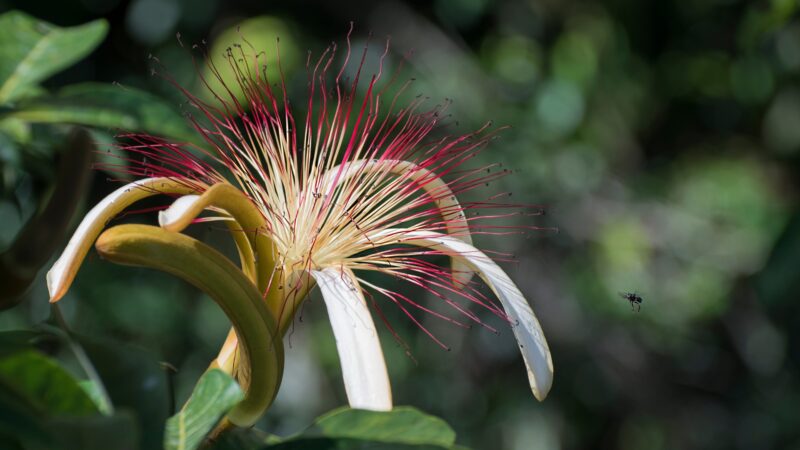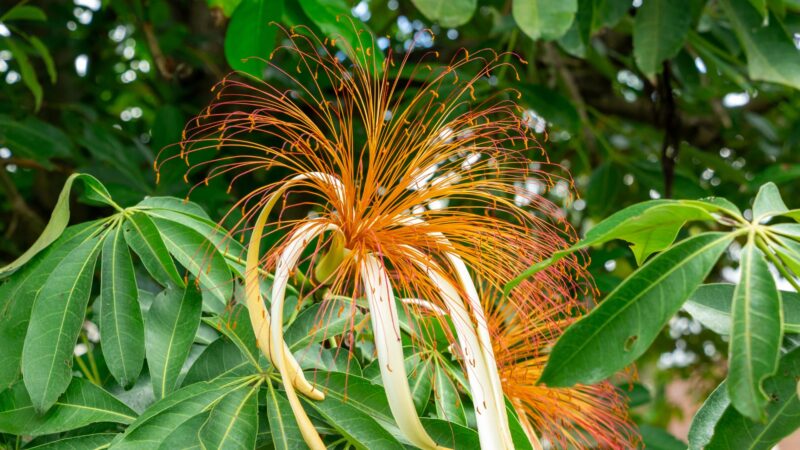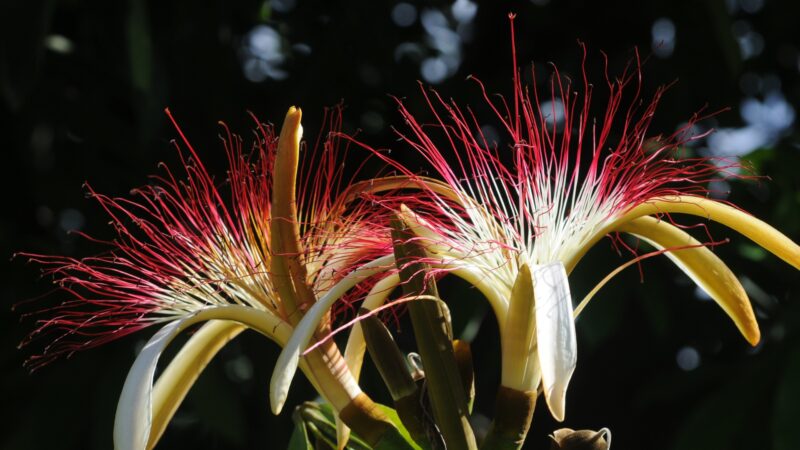If you’ve ever come across a beautiful plant with bountiful green leaves and its trunk braided, then you’re familiar with the money tree. Believed to bring prosperity to its owners, this unique plant is quite a popular gift item.
Curiously, how do you take care of such a peculiar tree? Does it require a special technique? But to ensure the best care for your money tree, you should start by identifying the causes of its death.
With that in mind, what are the causes of a dying money tree? The following are the seven causes of a dying money tree:
- It is suffering from root rot.
- It has been overwatered.
- It has been under-watered.
- It is suffering from light problems.
- It is suffering from inappropriate cultural conditions.
- There are issues with its repotting.
- There is a pest infestation.
If you want to know more about these causes, including the recommended solutions to revive your money tree, then you came to the right place. This article will also tackle preventive measures to make sure it doesn’t happen again.
So, what are you waiting for? Continue reading to know more about the causes of a dying money tree and how to revive it accordingly.
What Is a Money Tree?

The money tree is also known as pachira aquatica. It is a tropical plant that’s native to the wetlands of South and Central America. As such, it is known to thrive in warm temperatures with relative humidity.
Commonly, a money tree refers to an indoor plant with a braided trunk with bountiful green leaves. This plant usually grows up to 6.5 feet tall, while some may reach adulthood at a shorter stature. In contrast, the uninhibited pachira aquatica that grows in wetland areas can grow up to 60 feet tall.
While the origins of its common moniker are unknown, legend has it that a farmer became prosperous after selling multiple plants from the pachira aquatica that grew on his field. The farmer then credited his success to the plant and has then referred to it as a money tree.
Since then, the money tree has been associated with bringing luck and prosperity to its owners. This is why it became a popular indoor plant and gift item.
7 Causes of a Dying Money Tree

It is worth noting that money trees are among the low-maintenance indoor plants out there. It prefers a mid-humidity environment that’s warm and gives it indirect exposure to sunlight. Also, it needs infrequent watering as long as the soil moisture content is still above 50%.
However, like all plants, it is still susceptible to several factors that can lead to its wilting – and eventual death. With that said, here are the seven causes of a dying money tree, including tips on how to revive it and prevent its recurrence.
Root Rot
One of the most common causes of a dying money tree is root rot. This often takes place when the water did not drain properly. Either because the pot is clogged or there is improper air circulation inside the room.
Unfortunately, when there is root rot, the plant will not be able to absorb all the nutrients in the soil. This leads to stunted growth, yellowing leaves, and decaying plant parts.
- Symptoms: When a dying money tree is suffering from root rot, the common symptoms include discolored leaves that appear dry and wilting. If the root rot has progressed, you will also notice a foul smell stemming from the soil.
- Causes: The usual suspect for root rot is a clogged pot that does not drain properly, coupled with overwatering the soil and poor air circulation.
- How to revive: To revive a dying money tree due to root rot, the only solution is to transfer it to a new pot with new soil. But before doing so, you should carefully separate the damaged roots from the healthy ones with a clean pruning shear.
The Master Grade Bonsai Scissors, which is a pair of scissors specifically designed to cut damaged roots, is a good option to consider.
Once the damaged roots are separated, it’s best to wait for the roots to dry up before transferring them to a new pot. Always make sure to use well-draining sandy soil.
- How to prevent: To prevent root rot from happening, always check your money tree’s pot to make sure that it’s draining properly. It helps to add pebbles to the pot to ensure water drainage.
The Mosser Lee ML1121 River Rock Soil Cover in particular is especially used to line pots before the soil is added to ensure drainage and prevent clogging.
- Covers soil of indoor and container plants.
- Improves water drainage from soil when used to line the bottom of...
- Suitable for terrariums, aquariums, and dish gardens.
- Use in Craft and decorative projects.
- River rock soil cover
Overwatering
Like with all living things, money trees also need water to survive. However, providing it with more water than it needs can lead to its death. That’s why it’s only recommended to water your money tree when the moisture levels in the soil are below 50%.
- Symptoms: When a money tree is overwatered, it will show signs of wilting, along with mushy leaves that appear pale yellow or brown. It may also suffer from decaying roots, especially if these roots were soaked in water for extended periods.
- Causes: The money tree was given too much water or was watered frequently even when the soil still contained more than 50% moisture.
- How to revive: In the case of overwatering a dying money tree, the best way to save it is to leave it for a while and allow the water to drain. You may leave it under indirect sunlight for a while to help it dry out faster.
However, in case of severe damage, it’s best to uproot the money tree and allow the roots to dry for a while. Then, replant it in a new pot with dry soil and a well-draining pot. It also helps to prune the damaged parts, especially if the stems are already wilting.
- How to prevent: To prevent overwatering of your money tree, a good rule to follow is to water it only when the moisture content in the soil drops below 50%, especially when only 25% remains.
The Kawany Soil Moisture Meter is a good tool to use to check the soil’s moisture levels. Alternatively, you may opt to shower it with eight ounces of water every three weeks.
No products found.
Underwatering
Aside from overwatering a money tree, underwatering it can also cause severe damage. Bear in mind that water helps it stay hydrated while also aiding in its nutrient absorption. Thus, without enough water, your plant will surely start to wilt and die eventually.
- Symptoms: The earliest sign of a dehydrated money tree is its wrinkly leaves, even when it still appears green and glossy. In case the condition has progressed for the worst, the tips of the leaves will begin to curl, and the leaves will turn brown.
- Causes: The money tree is not getting enough water.
- How to revive: If you notice the presence of the above symptoms on your money plant, then you should start by immediately showering it with water.
You would know that it’s getting enough water when water starts to drain from the drainage holes. Monitor the moisture content of the soil before watering it again to avoid overwatering it as it recovers.
- How to prevent: The best way to prevent underwatering a money plant is to water it when the soil’s moisture content drops below 50%. As much as possible, do not allow the soil’s moisture content to drop below 25%.
To know if the plant is getting enough water, simply shower it until water starts draining through the pot’s holes. After this, your plant may only need another watering after three weeks.
Light Problems
Interestingly, while money trees are tropical plants, they are quite sensitive to direct sunlight. Money trees prefer bright yet indirect sunlight to thrive. Otherwise, it can dry up or result in stunted growth.
- Symptoms: When a money tree isn’t getting the right amount of light, its leaves often turn brown or yellow. Additionally, these leaves also look dry and wrinkled.
- How to revive: If the money tree is placed indoors, the best way to revive it is to lower the brightness of its lamp. But if the plant is located outside, it’s best to keep it indoors for a while until the leaves look healthy again.
During its recovery period, make sure to water your money tree like usual. It also helps to remove the severely damaged or wilted leaves, so the plant is focused on growing new leaves or improving the condition of less damaged leaves.
- How to prevent: The ideal location for money trees is somewhere where it gets indirect exposure to sunlight. This includes a roofed balcony or a shades room near the window.
The key here is to find a place with medium lighting conditions that will promote healthy plant processes without causing the leaves to burn due to overexposure.
Inappropriate Cultural Conditions
By inappropriate cultural conditions, this means that the money tree is adjusting to its new environment. This is especially true if the money tree has been moved somewhere with a completely different climate from what it was used to. Unfortunately, money trees love familiarity, so being moved might stress them out for a while.
- Symptoms: Common symptoms shown by money trees in this situation include leaves falling off or turning yellow or brown.
- Causes: The main cause for inappropriate cultural conditions is that the money tree is moved to a new location.
- How to revive: Fortunately, this is a common occurrence for money trees. You simply have to wait for it to grow accustomed to its new environment.
- How to prevent: The best way to prevent stressing out your money tree after a move is to make sure it gets the ideal amount of sunlight and water. It also helps to monitor the humidity content in the air and make sure that it doesn’t drop below 30%.
Repotting
Transferring a money tree to a new pot is part of helping it grow. However, such transfer can also stress it out. This is especially true if you’re using soil that’s not supportive of its growth.
- Symptoms: If the money tree seems wilting or is lifeless immediately after its transfer, then it is suffering from repotting stress.
- Causes: The roots have not been established on the new soil, or the roots were damaged during the transfer.
- How to revive: In the case of repotting stress, the best solution is to make sure that the plant’s surroundings are in their ideal conditions. This includes indirect sunlight, temperatures ranging between 65 to 80°F, and mid-humidity levels not lower than 30%.
These are in addition to regular watering once every three weeks. By doing so, you are reducing the stress being experienced by the money tree to encourage its revival.
- How to prevent: To prevent repotting stress from ever taking place, you have to make sure not to damage the roots. It also helps to use well-draining sandy soil to make sure the leaves are established after repotting. And as a rule, don’t repot your money tree more than once every three years to avoid stressing it out.
Pest Infestation
Money trees are especially attractive to pests because of their sugary sap. Particularly, it’s known to draw the attention of aphids and mealybugs. Unfortunately, these pests can cause damage to its leaves and trunk, which will eventually lead to its death.
- Symptoms: Aphids and mealybugs are visible to the naked eye so a pest infestation will look like multiple black clusters are walking all over the plant. You will also observe the presence of holes in leaves. In some cases, its usually glossy leaves will appear dull and dusty from afar.
- Causes: One insect made its way to the plant and discovered its sweet sap.
- How to revive: The only way to get rid of these pests is to spray insecticidal soap onto the plant to kill them. An organic insecticide such as the Espoma Organic Earth-Tone Insecticidal Soap will not only kill these pests but will also prevent their re-infestation. Once you have gotten rid of the pests, you can start separating the damaged parts of the plant to help it recover faster.
- Controls pests such as aphids lace bugs mites grasshoppers scale...
- For use on fruit and nut trees vegetables Ornamental and bedding...
- Made from plant oils and contains no animal fatty acids
- Used indoors or outdoors
- How to prevent: To prevent another pest infestation, it’s best to spray insecticidal soap onto the plant in the early spring. These pests are especially active during the warm summer months, so covering your money tree with insecticide before the temperatures rise will stop them in their tracks.
Tips on Keeping Your Money Tree Healthy

While the money tree is a low-maintenance plant, it still needs your care and attention to grow healthy. Keep these pointers in mind to keep it from dying.
- Water it when necessary. Money trees do not need much water to survive. It only needs water once every three weeks or later. A good rule to keep in mind is that, for every watering session, money trees only need around six to eight ounces of water.
- Money trees prefer indirect but bright sunlight. While money trees need sunlight or other bright light sources to ensure their survival, direct exposure to sunlight can burn their leaves or cause them to be dehydrated. Thus, it’s ideal to keep it indoors, or in a shaded area in your garden or patio.
- Prune regularly. Wilting and rotting plant parts will be part of its normal cycle. If you ever encounter them, make sure to prune them immediately – especially if the damage is too severe already. By doing so, the money tree is encouraged to focus on growing new and healthy leaves.
- Monitor the humidity levels. As tropical plants, money trees thrive in humid environments. Particularly, where the air has a moisture content exceeding 30%, your money tree will grow healthy and will thank you for it. Thus, once humidity levels drop below this threshold, make sure to adjust your humidifier’s settings accordingly.
- Take note of the room temperature. Money trees love warm temperatures ranging between 65 to 80°F. If it’s too hot, its leaves might burn and become dehydrated; and if it’s too cold, it may not develop completely. Thus, it helps to pay attention to the environment’s temperature to keep your plant happy and healthy.


